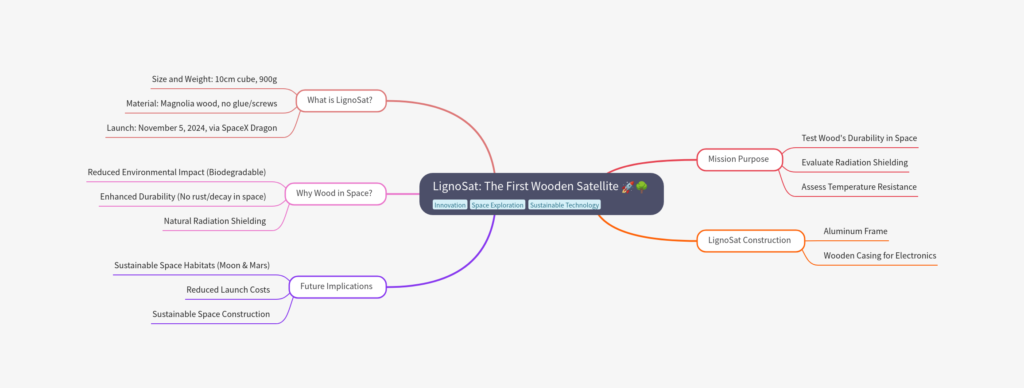Table of Contents
MindMap of the content

Introduction
Another remarkable date has been marked as the history of space exploration – November 5, 2024, is known as the day of LignoSat launch – the first satellite covered with wooden panels. It is a product of Kyoto University in collaboration with the Sumitomo Forestry; LignoSat got sent to the International Space Station on SpaceX’s Dragon capsule – the first of its kind. The size of a loaf of bread and carved from magnolia wood, this cuboidal satellite will assess the possibility of timber use in space construction with an eye to the future.
Here in this blog, you will learn more about what sets LignoSat apart from other ventures, why wood is being looked at as potential material to be used in space, as well as the wider implications of this exciting mission.
What is LignoSat?

LignoSat is a low orbit satellite with dimensions of 10 centimeters along each side and weights 900 grams like a Rubik’s cube. Its construction from very beautiful magnolia wood, carefully carved panels, gives references to the Japanese culture, but the craftsmen did not use screws or glue. LignoSat was constructed with this material and architectural style, due to the Japanese inclination of venerating wood that has been in existence for centuries.
The name of LignoSat is based on the Latin word for wood, which refers to the composition of the product.
But why wood? Aluminum or titanium are standard material choices in spaces agencies and among engineers because components designed for use in space must have high durability. Nonetheless, this option is not developed yet and if successful, it could radically shift the way that satellites and space probes are built sustainably.
Mission Purpose: Proving the Sustainability of Wood in Space
The main goal of LignoSat is just to find out whether or not the wood is capable of withstanding the challenges of space conditions. In orbit, temperature variations may range between -100 degrees Celsius, and 100 degrees Celsius within 45 minutes. This daily variation of temperature is very damaging to materials because it weakens even metals and bends or splits them, causing them to become very brittle.
LignoSat will note the performance of wood against these adversities, and how the material shields delicate electronic instruments and parts in space.
As an extension, the effectiveness of wood will also be evaluated when subjected to radiation typical of space conditions. Satellites receive large doses of Cosmic radiation and solar flares capable of damaging onboard semiconductors and Electronics. The original magnolia wood used in LignoSat’s panels could perhaps act as a natural shield against radiation, helping to lengthen the lifespan of sensitive internal elements.
Wood in Aviation and Aerospace
Even though the existence of a wooden satellite may come as a shock, wood has been used widely throughout aviation, especially in its early stages. In the early stages of flying innovations such as the one presented in the picture most flight instruments or rather airplanes were developed utilizing wood as it was light, strong and more importantly, easily accessible. Aviation – making people fly When the Wright brothers were inventing airplanes and during the First World War, when the great advanced fighter planes were being created, wood was an important element in getting people into the air.
Wood was used dominantly during childhood of aviation but was gradually replaced by metal in later stages. But materials science has progressed a great deal since then, and nowadays wood can be engineered in order to better handle more severe conditions, which is why it can be used on spacecraft now. Other natural materials such as cork have been utilized in space missions with regards to use of insulation and to guard spacecraft from the heat likely to be encountered during re-entry. LignoSat could be a start in a new quest of organic materials in space uses.
Why Wood in Space? Key Advantages of Wood as a Space Material
Reduced Environmental Impact:
LignoSat is an innovative and even risky technologic endeavor for the company but it is also an introduction of an environmentally friendly strategy. To this end, wood as the main material for building satellites is more environmentally friendly when compared with the metallic type like aluminum used in conventional satellites.
After the metal satellites are used, they also fall back onto Earth and when they re-enter Earth’s atmosphere they burn up and cause pollution and destroy the ozone layer through the release of aluminum oxides. Similarly, wooden satellites should pose a lower threat and burn up without emitting most toxic materials and gases.
Enhanced Durability in Space:
That is why although wood rots on the Eath due to moisture, bacteria and fungi similar processes do not occur in space because there is no water and oxygen in space. Ironically, wood’s rigidity within space might help make it a stronger option than a number of the metals themselves, as it may not rust/decay in space.
Since it cannot burn without oxygen, wood is also an even safer material as far as flammability is concerned in space – again a critical consideration when voyaging to space.
Potential for Natural Radiation Shielding:
The satellite’s electronics could be naturally shielded from radiation by Magnolia wood. Wood’s cellular structure might in fact capture or deter specific ranges of cosmic rays and radiation, inherently giving passive protection without the necessity of costly layers of shielding.
It could also have the exciting possibility to decrease the overall weight and therefore the complexity of future satellites, leading to possibly lower launch costs.
Inside LignoSat: A Mix of Wood and Traditional Satellite Materials
LignoSat, in fact, is innovative in its use of wood but there are still some other conventional components. Most of the parts of the satellite are constructed using the aluminum frame; however, electronics used in the satellite are covered by the wooden casing. This blended method happily enables the scientists to gauge the efficiency of the wood without necessarily having to risk the rigidity and operation sensitivity required for an effective mission in space.
The expectations of LignoSat are that during its half a year spent in orbit, its sensors will be able to gather valuable data about the temperature stability and radiation and mechanical strength resistance of magnolia wood. However, should the wood panel provide the necessary level of protection to the satellite’s components, it could open the door to more complicated applications of the material in future missions.
Environmental Benefits:
Contemporary satellites are a popular and considerable cause of space debris and pollution. The further implications of Aluminum Oxide further negatively affects the ozone layer when conventional satellites are burned in the earth’s atmosphere. There is, however, one potential idea for cutting costs that LignoSat employs: wood as the primary material.
Constructed from renewable wood, this enables the design of a satellite that is sustainable and biodegradable in orer to reduce the rate of space debris and also contribution towards the reduction of enviromental effects of disposal of satellites. Given that thousands of satellites are being launched annually, the issues with satellite components concern the environment. Timber-based satellites could be one of the possible revolutions that help make space missions more environmentally friendly and earth-saving.
Future Implications: The Vision for Wooden Habitats on the Moon and Mars
Satellite revolution of LignoSat could ultimately create a trend of wood aided uses in space not limited to panels only. Scientists at Kyoto University want to cultivate trees and build houses from timber on the Moon and Mars within the next five decades. It could be feasible and cost effectual to use wooden structures for habitats instead of metal structures thus not requiring to carry heavy structures from earth.
Such habitats would also qualify as an ecosystem with what appears to be a holistic cycle, and may possibly allow astronauts to gain sustainable supplies for construction, breathing and waste disposal. During some phase in space colonization the utilization of environmentally friendly products such as timber could support a more sustainable way of constructing outposts on other planets.
Conclusion
LignoSat is not just an innovative satellite but a glimpse into the future of sustainable space exploration. This ambitious mission seeks to test whether wood can endure the extreme conditions of space, with results that could revolutionize spacecraft construction and environmental sustainability in space missions.
The implications of LignoSat’s mission extend far beyond this one satellite. If successful, it will mark the beginning of a new era in which renewable materials, including wood, become commonplace in the design of satellites and habitats for space. As the world grapples with environmental challenges on Earth, LignoSat serves as a reminder that even our approach to space exploration must be mindful of sustainability.
In the future, wooden satellites may become a staple in the skies, signaling humanity’s shift toward sustainable technology, not just on Earth but across the cosmos.
FAQS
Q1. What is LignoSat?
Ans: LignoSat is the world’s first wood-panelled satellite, developed by Kyoto University and Sumitomo Forestry. This innovative satellite, made of magnolia wood, was launched into space on November 5, 2024, to test the viability of wood as a material for future space missions.
Q2. Why use wood for a satellite?
Ans: Wood is a renewable, environmentally friendly material. Unlike metals, it doesn’t release harmful oxides when burned upon re-entry. Additionally, in space’s vacuum environment, wood doesn’t rot or combust, and it could provide natural radiation shielding for satellite electronics.
Q3. How big is LignoSat?
Ans: LignoSat is a small cube-shaped satellite, measuring 10 cm on each side and weighing about 900 grams. It’s comparable in size to a Rubik’s cube.
Q4. What are LignoSat’s main objectives?
Ans: The mission will test wood’s durability under extreme temperature changes and high levels of space radiation. If successful, it could lead to more sustainable satellite construction, and wood may even be considered for future space habitats.
“I can’t express how valuable this post is! The level of detail and thoughtful explanations demonstrate your mastery of the subject. Truly a goldmine of information.”
Thanks for your comment please subscribe to this website so you can get daily updates for the post